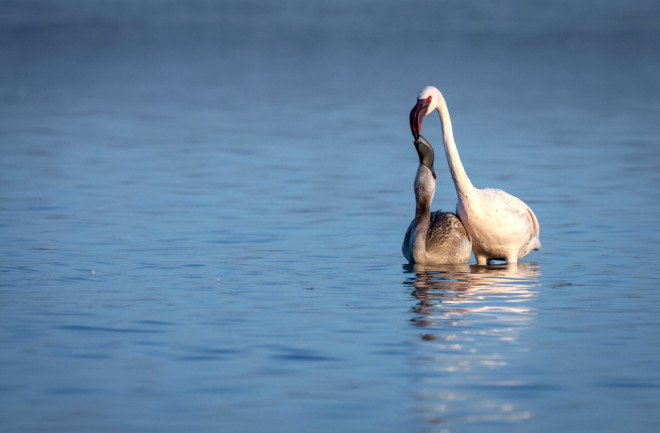A lesser flamingo parent feeds its chick at breeding site at Kamfers Dam, South Africa. A drought that hit the area earlier this year forced flamingo parents to abandon thousands of chicks, which sent volunteers scrambling to save the birds. (Credit: By Stephan Olivier/ shutterstock) The incessant “eep, eep, eep” of hundreds of hungry flamingo chicks bounces off the concrete walls of a feeding room at the SANCCOB wildlife sanctuary in Cape Town, South Africa. Teri Grendzinski reaches into a pen and plucks out a fluffy, pale pink chick. She grips it gently with one hand. The bird opens its mouth eagerly as her syringe squirts out a kind of warm shrimp milkshake. It’s noisy, hot work. To keep the chicks warm away from their nests, their rooms are heated to a balmy 86 degrees Fahrenheit. And there’s so many birds, volunteers have to feed them around the clock in shifts, mixing endless milkshakes and bringing in a fresh batch of flamingos as soon as the last one is finished. “(It was) overwhelming — in a good way,” says Grendzinski, an expert who normally works raising wild birds at the National Aviary in Pittsburgh. “There was so much work to be done. So much to be learned. … And we were running — sitting down was not an option.”
The Flamingos' Future: Lessons From A Race To Rescue Thousands of Abandoned Chicks

Newsletter
Sign up for our email newsletter for the latest science news
0 free articles left
Want More? Get unlimited access for as low as $1.99/month
Stay Curious
Sign up for our weekly newsletter and unlock one more article for free.
View our Privacy Policy
Want more?
Keep reading for as low as $1.99!
Already a subscriber?
Find my Subscription
More From Discover
Recommendations From Our Store
Shop Now
Stay Curious
Subscribe
To The Magazine
Save up to 40% off the cover price when you subscribe to Discover magazine.
Copyright © 2023 Kalmbach Media Co.
